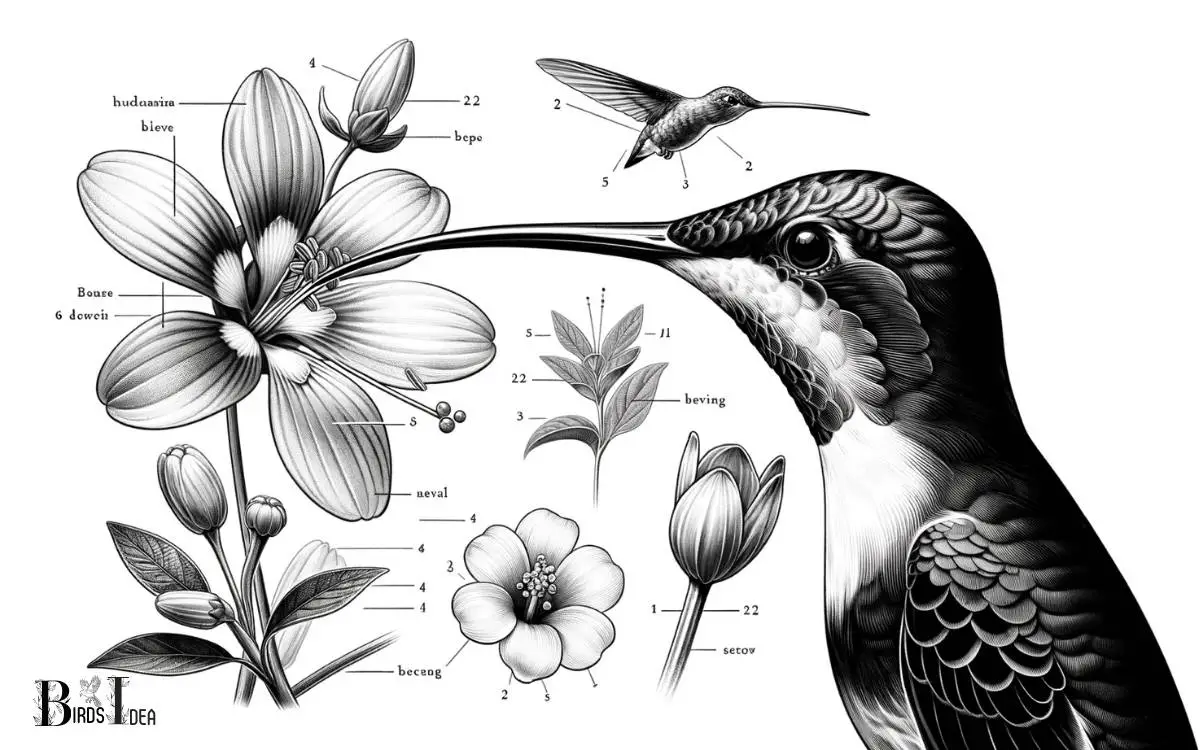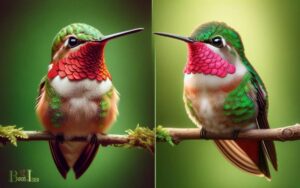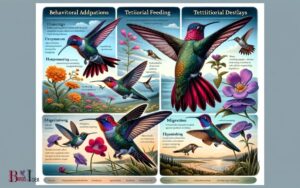What Type of Beak Does a Hummingbird Have? Explore!
Hummingbirds have long, narrow beaks that are highly specialized for extracting nectar from flowers.
These beaks are typically elongated and slender, allowing hummingbirds to reach deep into tubular flowers.
The shape and size of a hummingbird’s beak can vary among species, with some adapted to specific types of flowers.
The beak of a hummingbird is a marvel of evolution, perfectly designed for its primary food source: nectar. These birds have a variety of beak types, each suited to the flowers they frequent.
Here are some key features and adaptations:
Each hummingbird’s beak is a natural masterpiece, intricately shaped to access the sweet nectar that fuels their high-energy lifestyle.

Key Takeaway
4 Species of Hummingbird Beaks and Their Adaptations
| Species | Beak Type | Beak Length | Primary Food Source | Adaptation |
|---|---|---|---|---|
| Ruby-throated Hummingbird | Straight, slender | Medium | Tubular flowers | Generalist feeder |
| Sword-billed Hummingbird | Extremely long, straight | Very long | Deep flowers | Specialized for deep corollas |
| Buff-tailed Coronet | Short, straight | Short | Variety of flowers | Versatile for different flowers |
| Purple-throated Carib | Curved | Medium to long | Heliconia flowers | Matched to curved flowers |
Evolution of Hummingbird Beaks
The evolution of hummingbird beaks has been shaped by millions of years of natural selection, resulting in diverse and specialized adaptations for feeding and pollination.
Hummingbird beaks vary in shape and size, reflecting their diverse feeding behaviors and the specific flowers they have co-evolved with.
Some species have long, slender beaks ideal for reaching nectar in deep-throated flowers, while others have shorter, stouter beaks adapted for accessing more robust flowers.
The evolution of these specialized beak shapes has allowed hummingbirds to exploit a wide range of floral resources, contributing to their ecological success as important pollinators.
Additionally, the unique flexibility and rapid movements of hummingbird beaks have further enhanced their efficiency in feeding and pollination, showcasing the remarkable adaptations that have evolved over time.
Anatomy of a Hummingbird Beak
Hummingbird beaks feature a unique combination of slender, elongated shape and rapid, precise movements, enabling them to efficiently access nectar from flowers and fulfill their role as important pollinators.
The anatomy of a hummingbird beak is fascinating and serves a specific purpose in their survival and reproduction.
Here are three key aspects of the hummingbird beak:
- Specialized shape: The beak is long, slender, and tapers to a fine point, allowing hummingbirds to reach the nectar deep within flowers.
- Flexible structure: The beak is highly flexible, allowing for precise control and rapid movements to access nectar from various angles and floral shapes.
- Sensory receptors: Hummingbird beaks contain sensory receptors that help them detect the sugar content of the nectar, enabling them to select the most energy-rich food sources.
Specialized Adaptations for Feeding
With specialized adaptations for feeding, hummingbirds have evolved remarkable abilities to efficiently extract nectar from flowers.
Their long, slender beaks are perfectly shaped to probe deep into the corollas of flowers, reaching the nectar hidden within.
The beak’s length allows hummingbirds to access a wide variety of flower shapes and sizes, while its specialized tongue, which can extend beyond the beak, is equipped with tiny, hair-like structures to help lap up the nectar.
Additionally, the rapid and precise movements of their beaks enable them to hover in front of flowers and feed while in flight.
These specialized adaptations not only facilitate efficient nectar extraction but also play a crucial role in the pollination of flowers, making hummingbirds an integral part of many ecosystems.
Diversity of Hummingbird Beak Shapes
Hummingbirds exhibit an impressive diversity of beak shapes, each uniquely adapted to specific feeding behaviors and environmental conditions.
The variation in beak morphology plays a crucial role in the birds’ ability to obtain nectar from flowers, feed on insects, and even defend territories.
Understanding the evolutionary advantages of such beak diversity provides valuable insights into the ecological interactions and adaptive strategies of these remarkable avian species.
Beak Shape Adaptation
The diversity of hummingbird beak shapes allows for specialized adaptations to various feeding niches.
This diversity is a result of evolutionary pressure, with different beak shapes being suited to different types of food sources.
Some of the key adaptations in hummingbird beak shapes include:
- Long, slender beaks: These beaks are adapted for accessing nectar deep within long, tubular flowers.
- Short, sturdy beaks: These beaks are adapted for consuming insects and spiders, providing the necessary strength and precision for catching small prey.
- Curved, decurved beaks: These beaks are adapted for extracting nectar from specific types of flowers, often with specialized shapes that match the unique structure of certain blooms.
These specialized adaptations in beak shapes allow hummingbirds to efficiently exploit a wide range of food sources in their environment.
Understanding these adaptations enriches our appreciation of the intricate relationship between hummingbirds and their ecological niches.
Feeding and Pollination
Adapted beak shapes enable hummingbirds to effectively forage for nectar and pollen, thereby contributing significantly to the pollination of diverse plant species in their ecosystems.
The diversity of hummingbird beak shapes allows for specialization in feeding on different types of flowers.
For instance, the long, slender beaks of some hummingbird species are well-suited for feeding on tubular flowers, while others with shorter, stouter beaks are adapted for flowers with more open shapes.
This specialization allows for reduced competition for food sources among hummingbird species.
The following table illustrates the diversity of hummingbird beak shapes and the corresponding flower types they are adapted to feed on:
| Beak Shape | Adaptation |
|---|---|
| Long and slender | Feeding on tubular flowers |
| Short and stout | Feeding on flowers with more open shapes |
This specialization plays a crucial role in the pollination of a wide variety of plant species in hummingbird habitats.
Evolutionary Advantages of Beak Diversity
Diverse beak shapes in hummingbirds confer evolutionary advantages by facilitating specialized feeding on various flower types, thereby contributing to the pollination of a wide array of plant species.
This diversity allows hummingbirds to exploit different floral resources, leading to the following benefits:
- Specialization: Hummingbirds with longer, more curved beaks are adapted to feed on flowers with long corollas, while those with shorter, straighter beaks can access a broader range of flower shapes.
- Niche Differentiation: Beak diversity enables coexistence among different hummingbird species by reducing competition for floral resources. This facilitates the partitioning of ecological niches, promoting biodiversity within ecosystems.
- Coevolution: The diverse beak shapes of hummingbirds have driven the coevolution of flowers, leading to a remarkable diversity of floral structures and nectar compositions, ultimately benefiting both the birds and the plants.
Role of Beak in Pollination
Hummingbirds frequently play a vital role in pollination due to the unique structure and function of their beaks.
The long, thin, and tapered shape of their beaks allows them to reach deep into tubular flowers to access nectar, while their specialized tongue and brush-like tip enable them to extract it efficiently.
As they feed, their heads come into contact with the reproductive organs of the flowers, leading to the transfer of pollen from one bloom to another.
This process, known as “hummingbird pollination,” facilitates the fertilization of the plants and contributes to the genetic diversity of floral populations.
Furthermore, the remarkable hovering ability of hummingbirds enables them to visit numerous flowers in a short period, making them effective and important pollinators in various ecosystems.
Beak and Foraging Behavior
The unique beak of a hummingbird is intricately adapted to its foraging behavior and food sources.
The beak shape and size allow for the extraction of nectar from flowers, while the specialized tip enables them to catch small insects and spiders.
Understanding the relationship between the hummingbird’s beak and its foraging behavior provides valuable insights into its ecological niche and evolutionary adaptations.
Hummingbird Beak Adaptations
Hummingbirds’ beak adaptations play a crucial role in their foraging behavior, allowing them to efficiently extract nectar from flowers.
These adaptations include:
- Specialized shape: Hummingbird beaks are long and slender, allowing them to reach deep into tubular flowers to access nectar. The elongated, tapered shape of their beaks enables them to efficiently extract nectar from the depths of flowers.
- Sensitive sensory organs: Hummingbirds have specialized sensory receptors at the tip of their beaks, which help them detect the sugar content of the nectar. This allows them to select flowers with the highest energy reward, optimizing their foraging efforts.
- Precise control: Hummingbirds have remarkable control over their beaks, enabling them to precisely position and manipulate their beaks within the complex structures of flowers, extracting nectar with incredible dexterity.
Foraging and Food Sources
In the context of foraging and food sources, the specialized shape and sensory adaptations of a hummingbird’s beak enable it to efficiently extract nectar from flowers and select the highest energy reward.
Hummingbirds primarily feed on nectar, but they also consume insects and spiders for protein.
Their long, slender bills allow them to reach deep into tubular flowers, while their extended, grooved tongues draw the nectar up into their mouths.
The following table provides examples of common flower types and the corresponding beak adaptations and foraging behaviors of hummingbirds:
| Flower Type | Beak Adaptation | Foraging Behavior |
|---|---|---|
| Tubular | Long, slender beak | Hovering while probing deep into flowers |
| Trumpet-shaped | Curved beak | Perching to access nectar at the base of the flower |
| Wide, shallow | Short beak | Hovering and sipping nectar from the surface of the flower |
Hummingbirds’ remarkable beak adaptations and foraging behaviors allow them to efficiently access a wide variety of floral resources.
Conservation Implications
Adapting to changes in their habitat, hummingbirds’ specialized beaks play a crucial role in their survival, highlighting the need for targeted conservation efforts.
The following are key conservation implications related to hummingbirds’ specialized beaks:
- Habitat Preservation: Protecting the diverse habitats where hummingbirds reside is essential for ensuring the availability of their specialized food sources, such as nectar from flowers and small insects.
- Climate Change Adaptation: As climate change alters the distribution of flowering plants and insects, conservation efforts must focus on creating corridors and suitable habitats for hummingbirds to sustain their specialized foraging needs.
- Education and Awareness: Increasing public awareness about the importance of preserving hummingbirds’ habitats and the role of their specialized beaks in pollination can garner support for conservation initiatives and encourage sustainable practices.
These implications underscore the necessity of prioritizing conservation strategies to safeguard the unique feeding adaptations of hummingbirds.
Conclusion
The diverse and specialized beak shapes of hummingbirds have evolved to facilitate their unique feeding behaviors and play a crucial role in pollination.
The intricate anatomy of their beaks allows for efficient foraging and nectar extraction, making them essential to the survival of many plant species.
The remarkable adaptability and versatility of hummingbird beaks can be likened to a Swiss army knife, demonstrating their indispensable role in the ecosystem.






